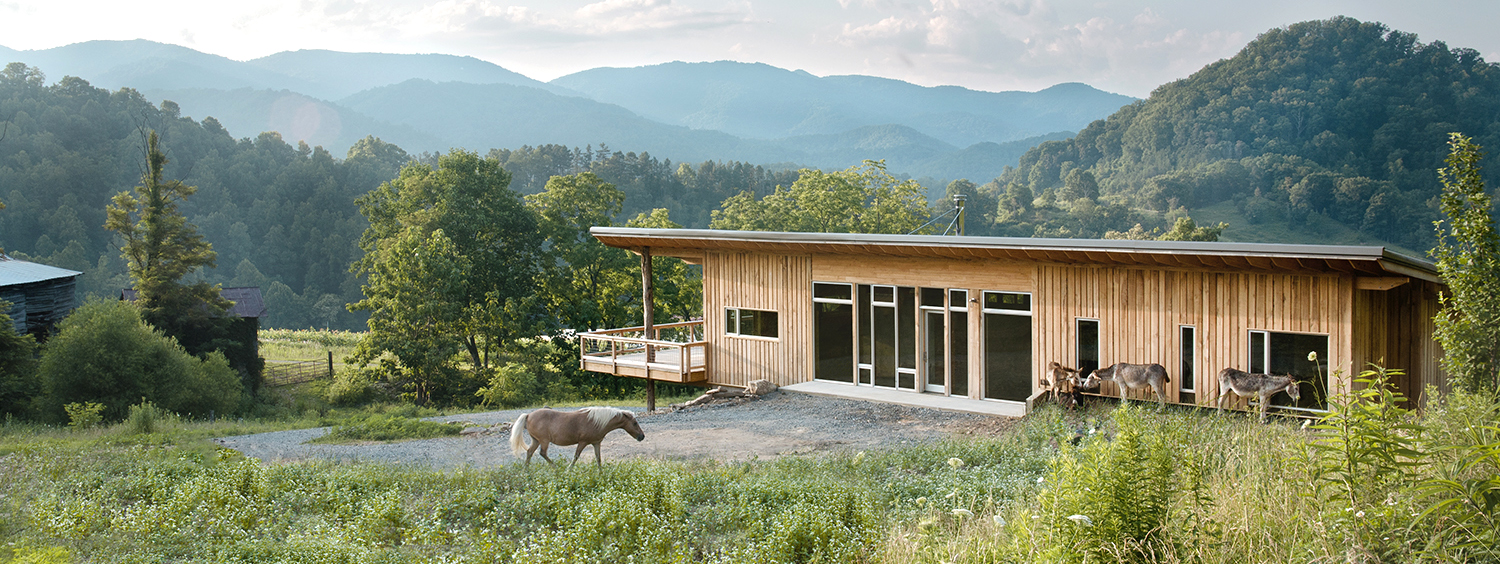Asheville Modern
An Asheville Modern Architecture – Merging Modern Sensibilities And Design With The Vernacular Influences Of Materiality, Geography & Culture Specific To The Western North Carolina Mountains
 Throughout my career I’ve maintained a focus to reconcile the ideals and simplicity of Modern Architecture with the vernacular influences of place, materiality and culture in order to establish a clear Asheville modern architectural language. It should not be the primary mission of architecture to willfully attempt to change the course of a culture nor to produce stylistic replicas of a time past. Rather architecture must synthesize the social realities and cultural expressions with the physicality of place, materiality and local skill. Today the homogeneity of our techno-rationally biased and economy-obsessed built landscape have become all too familiar and impair our collective sense of local identity and uniqueness. The so-called standard of building today accelerates estrangement and alienation instead of celebrating each person’s unique individual and expressive character; their identity. This distance between the built form and the individual hastens the need for an elevated level of quality and craftsmanship through design.
Throughout my career I’ve maintained a focus to reconcile the ideals and simplicity of Modern Architecture with the vernacular influences of place, materiality and culture in order to establish a clear Asheville modern architectural language. It should not be the primary mission of architecture to willfully attempt to change the course of a culture nor to produce stylistic replicas of a time past. Rather architecture must synthesize the social realities and cultural expressions with the physicality of place, materiality and local skill. Today the homogeneity of our techno-rationally biased and economy-obsessed built landscape have become all too familiar and impair our collective sense of local identity and uniqueness. The so-called standard of building today accelerates estrangement and alienation instead of celebrating each person’s unique individual and expressive character; their identity. This distance between the built form and the individual hastens the need for an elevated level of quality and craftsmanship through design.
It was emphasized early in my education at Virginia Tech in Blacksburg, Virginia that architecture is an expressive art with the capacity to move us emotionally, spiritually and that buildings have the unique power and obligation to enhance the context in which they are sited in order to establish an identity independent of fashionable styles. The influence of utilitarian structures took the place of iconic traditional or modern buildings as objects for contemplation. The result became an effort to synthesize vernacular tradition with a modern language to create an architecture firmly rooted in its own place and time.
Strapped with boundless idealism and a sense of purpose I headed to Chicago and then to New York City to hone my skills and development as a designer. Over 16 years, as the scope and budget of projects increased exponentially when compared with my modest existence, I began to question the absolute dogma of a Modernism’s universal utopia versus a simplified contextual hand-crafted modern. What were the so-called fruits of my labor? Specifying rare exotic stone from the depths of China, endangered timbers from South America or synthetic forms devoid of the hand seemed best suited for the glossy pages of popular magazines and less to do with our current collective reality rife with environmental depletion, economic uncertainty, exportation of traditional skill and cultural identity. I asked myself, “why must progressive architectural innovation of the highest order remain the privilege of so few?” Was I practicing what I preach? I began to realize that the true challenge of a skilled architect is to do more with less, not create in excess with more. And thus began the closing of my circle of experience and a clear direction “home” revealed itself.
One-to-one in architectural terms typically means to work at full-scale; one inch equals one inch. A major philosophical component in my work has come to mean having empathy for and relating to my clients was well as all those whom may be effected by my efforts. Returning to Appalachia, the region that has continuously influenced my work and core philosophy over the years, seems to complete the circle and fulfill a desire to define a new architectural language specific to our shared time and place. While remaining independent of stylistic replication, commercial influence and remaining true to the ideals of modern architecture I am proud to call Asheville my home and hope to create thoughts, works of art and architecture that encourage the community to think about style, function, and the true purpose of our shared creative and architectural identity; an Asheville modern architecture that celebrates as opposed to replicates and stands firm, independent and proud.
